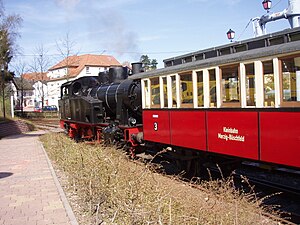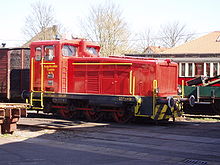Merzig Süd – Büschfeld railway line
| Merzig South-Büschfeld (MBE) | |||||||||||||||||||||||||||||||||||||||||||||||||||||||||||||||||||||||||||||||||
|---|---|---|---|---|---|---|---|---|---|---|---|---|---|---|---|---|---|---|---|---|---|---|---|---|---|---|---|---|---|---|---|---|---|---|---|---|---|---|---|---|---|---|---|---|---|---|---|---|---|---|---|---|---|---|---|---|---|---|---|---|---|---|---|---|---|---|---|---|---|---|---|---|---|---|---|---|---|---|---|---|---|
|
Museum train in Losheim
| |||||||||||||||||||||||||||||||||||||||||||||||||||||||||||||||||||||||||||||||||
| Route number (DB) : | 3218 | ||||||||||||||||||||||||||||||||||||||||||||||||||||||||||||||||||||||||||||||||
| Course book section (DB) : | formerly 265f | ||||||||||||||||||||||||||||||||||||||||||||||||||||||||||||||||||||||||||||||||
| Route length: | 22.5 km | ||||||||||||||||||||||||||||||||||||||||||||||||||||||||||||||||||||||||||||||||
| Gauge : | 1435 mm ( standard gauge ) | ||||||||||||||||||||||||||||||||||||||||||||||||||||||||||||||||||||||||||||||||
Kilometers differ depending on the source |
|||||||||||||||||||||||||||||||||||||||||||||||||||||||||||||||||||||||||||||||||
The Merzig Süd – Büschfeld (Merzig-Büschfelder Eisenbahn) railway was a standard-gauge railway line and connected the Saar Valley near the Saarland district town of Merzig with the Saarbrücken – Lebach – Nonnweiler state railway on the southwestern edge of the Hunsrück .
Origin of the railway
The 22 km long route was opened on July 6, 1903 under the company Kleinbahn Merzig-Büschfeld GmbH , which was founded on September 27, 1901. This name was not changed until 1942.
Merzig-Büschfelder Eisenbahn GmbH
One third of the shares in the GmbH were divided between the Prussian state, the provincial association of the Rhine Province and the Merzig district; In 1961 the owners were the Federal Republic of Germany, the Rhineland Regional Association and the Merzig-Wadern district . Soon after, Saarland became the sole shareholder in the GmbH.
After the First World War, the Merzig district was partially assigned to the Saar area; the railway crossed the border to the Rhine province between Bachem and Losheim, where the respective customs offices were set up. Although the new situation of the railway brought many difficulties, the trains ran continuously in the newly created remaining circle of Wadern. After the Saar was re-incorporated into the German Reich in 1935, the company's economic situation improved considerably. However, the Second World War brought - especially in the final phase - considerable restrictions and destruction.
The locomotives were: in 1939 four steam locomotives and one railcar, in 1961 two Jung R 30 C diesel locomotives and five railcars, in 1975 only the two diesel locomotives.
Decrease in traffic
Gradual shutdown began at the end of the 1950s. From November 1, 1959, the railcars only ran as far as Losheim and from May 26, 1962, passenger traffic ceased on the entire route. Freight traffic between Nunkirchen and Büschfeld came to a standstill on April 1, 1960, but stayed on the remaining section until the end of 1987. Then the license for rail traffic expired. Freight traffic was only possible between Merzig and Merzig Ost until December 15, 2002.
The railway company had already opened its own transport company on February 1, 1953, which in 1961 owned thirteen buses. In 1975 there were already 24 buses with which five lines in the district and beyond to Völklingen and one city line in Merzig were served. In the beginning there was one truck and in 1975 there were seven trucks with trailers for goods traffic on the road. MBE's bus service was also given up at the end of 1987 and taken over by the Deutsche Bundesbahn's rail bus division.
Museum train
The Museums-Eisenbahn-Club Losheim (MECL) has been running the remaining MBE route since 1982 : in 1988 it was granted the concession for occasional traffic on the Merzig Ost – Losheim – Nunkirchen route. Two steam and five diesel locomotives are available for this. Currently, the route is driven one to two days a month to Dellborner Mühle, 1.4 km east of Niederlosheim.
Resumption of freight traffic in 2007
After the rail connection to the Homanit between Niederlosheim and Münchweiler was also shut down in 2001, the wood processing company put its siding back into operation in September 2007 for ecological and logistical reasons and opened it with a ceremony on October 25 in the presence of many state and local politicians. First of all, a freight train should travel from Dillingen via Merzig to Homanit and back once a week. The clock frequency is to be increased in the future. The reactivation of the railway line met with broad approval. After a short time, however, the operation of rail freight transport was discontinued for economic reasons, and logistics are again on the road.
literature
- Gerd Wolff: German small and private railways . tape 1 : Rhineland-Palatinate / Saarland . Eisenbahn-Kurier , Freiburg 1989, ISBN 3-88255-651-X .
- Evert Heusinkveld, Georg Dollwet: The Merzig – Büschfeld Kleinbahn (= branch line documentation . No. 76 ). Kenning, Nordhorn 2003, ISBN 3-933613-61-2 .
- Heribert Scheubly: The history of the "MBE" - a borderland fate in New Trierisches Jahrbuch 1963


